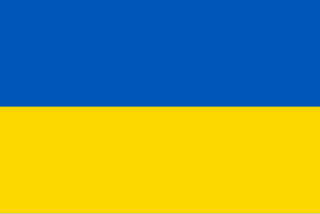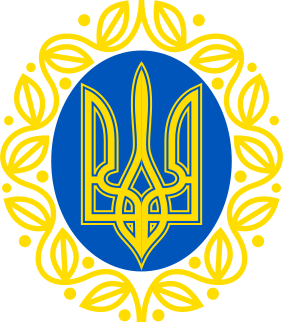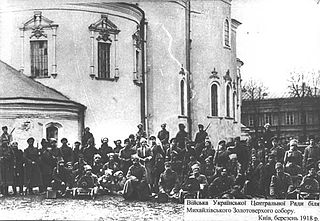 W
WThe Ukrainian People's Republic (UPR), or Ukrainian National Republic (UNR), was declared in Ukraine following the February Revolution in Russia. In March 1917 the National Congress in Kyiv elected the Central Council composed of socialist parties on the same principles as throughout the rest of the Russian Republic. The republic's autonomy was recognized by the Provisional government of Russian Republic. Following the October Revolution in Russia and aggression of the newly formed Bolshevik Russia against Ukraine, it proclaimed its independence from the Russian Republic on 25 January 1918.
 W
WVarious factions fought over Ukrainian territory after the collapse of the Russian Empire following the Russian Revolution of 1917 and after the First World War ended in 1918, resulting in the collapse of Austria-Hungary, which had ruled Ukrainian Galicia. The crumbling of the empires had a great effect on the Ukrainian nationalist movement, and in a short period of four years a number of Ukrainian governments sprang up. This period was characterized by optimism and by nation-building, as well as by chaos and civil war. Matters stabilized somewhat in 1921 with the territory of modern-day Ukraine divided between Soviet Ukraine and Poland, and with small ethnic-Ukrainian regions belonging to Czechoslovakia and to Romania.
 W
WThe Battle of Kiev of January 1918 was a Bolshevik military operation of Petrograd and Moscow Red Guard formations directed to capture the capital of Ukraine. The operation was led by Red Guards commander Mikhail Artemyevich Muravyov as part of the Soviet expeditionary force against Kaledin and the Central Council of Ukraine. The storming of Kiev (Kyiv) took place during the ongoing peace negotiations at Brest-Litovsk on February 5–8, 1918. The operation resulted in the occupation of the city by Bolshevik troops on February 9 and the evacuation of the Ukrainian government to Zhytomyr.
 W
WThe Battle of Kruty took place on January 29 or 30, 1918, near Kruty railway station, about 130 kilometres (81 mi) northeast of Kyiv, Ukraine, which at the time was part of Nezhinsky Uyezd of Chernigov Governorate.
 W
WThe Battle of Motovilivka was a military engagement fought between forces of the Ukrainian State and the Directorate of Ukraine. The battle took place on 18 November 1918 during the Ukrainian Civil War, and resulted in a major victory for the Directorate. The battle resulted in the eventual collapse of the Ukrainian State in December 1918.
 W
WCombatants of the Ukrainian People's Republic (UNR) Army were interned in Poland initially at the end of 1919 in Łańcut immediately after they organized six Rifle divisions. After the defeat of the UNR Army at the end of 1920 and its crossing over to Polish territory, about 20,000 soldiers were placed in a number of Internment camps, the most important were in Łańcut, Aleksandrów Kujawski and Kalisz. In mid 1921, the internees were transferred from Łańcut to Strzałkowo and at the end of 1921 from Aleksandrów to Szczypiorno, as well as to neighbouring Kalisz. The internment camps remained until their final liquidation in the middle of 1924.
 W
WThe Central Council of Ukraine was the All-Ukrainian council (soviet) that united deputies of soldiers, workers, and peasants deputies as well as few members of political, public, cultural and professional organizations of the Ukrainian People's Republic. After the All-Ukrainian National Congress, the Council became the revolutionary parliament in the interbellum lasting until the Ukrainian-Soviet War. Unlike many other councils (soviets) in the Russian Republic, bolshevization of this soviet failed completely causing members of the Russian Social Democratic Labour Party (Bolsheviks) in Ukraine, also known as Social-Democracy of Ukraine, to relocate to Kharkiv.
 W
WThe Constitution of Ukrainian National Republic is a constitutional document approved by the Central Rada on April 29, 1918, but never promulgated. Hence the document never acquired the legal power. Nevertheless, it remains an important document from the period of the Ukrainian National Republic from 1917-1918.
 W
WThe Directorate, or Directory was a provisional collegiate revolutionary state committee of the Ukrainian People's Republic, initially formed on November 13–14, 1918 during a session of the Ukrainian National Union in rebellion against Skoropadsky's regime. During the overthrow of Pavlo Skoropadsky it was named as the Executive Council of the State Affairs. Its authority was extended by the Labor Congress of Ukraine on January 23–28, 1919.
 W
WFree Cossacks were Ukrainian Cossacks that were organized as volunteer militia units in the spring of 1917 in the Ukrainian People's Republic. The Free Cossacks are seen as precursors of the modern Ukrainian national law enforcement organizations such as the National Guard of Ukraine or the Internal Troops of Ukraine.
 W
WThe General Secretariat of Ukraine was the autonomous Ukrainian executive government of the Russian Republic from June 28, 1917 to January 22, 1918. For most of its existence it was headed by Volodymyr Vynnychenko.
 W
WKholodny Yar Republic, Cold Ravine Republic or Kholodnoyarsk Republic (1919–1922) was a self-proclaimed state formation, partisan movement, which declared UNR government and ran on the lands of the Ukrainian People's Republic (UPR), in the Chyhyryn district of the Kyiv province, in the area of the Kholodny Yar forest tract. The village of Melnyky was its capital. It had a 15,000-strong army composed of peasants and soldiers of the Ukrainian National Republic army, which was defeated by the White Army in Podolia earlier.
 W
WThe Khotyn Uprising was a Ukrainian-led insurrection in the far-northern tip of Bessarabia region, nestled between Bukovina and Podolia. It occurred on January 7–February 1, 1919, less than a year after Bessarabia's annexation by the Romanian Kingdom. The city it was centered on is now known as Khotyn (Хотин), and is located in Chernivtsi Oblast, Ukraine; in 1919, it was the capital of Hotin County, on the unofficial border between Romania and the Ukrainian People's Republic (UNR). The revolt was carried out by armed locals, mainly Ukrainian peasants, assisted by Cossack deserters from the Ukrainian People's Army and groups of Moldovans, with some support from local Bolsheviks and White Russians. It forms part of the Ukrainian War of Independence, though whether or not the UNR covertly supported it, beyond formally reneging it, is a matter of dispute. The role of Bolsheviks, which has been traditionally highlighted in Romanian and Soviet historiography alike, is similarly debated. The Khotyn Uprising is therefore ambiguously linked to the Russian Civil War and the Ukrainian–Soviet War.
 W
WThe Central Council of Ukraine was the All-Ukrainian council (soviet) that united deputies of soldiers, workers, and peasants deputies as well as few members of political, public, cultural and professional organizations of the Ukrainian People's Republic. After the All-Ukrainian National Congress, the Council became the revolutionary parliament in the interbellum lasting until the Ukrainian-Soviet War. Unlike many other councils (soviets) in the Russian Republic, bolshevization of this soviet failed completely causing members of the Russian Social Democratic Labour Party (Bolsheviks) in Ukraine, also known as Social-Democracy of Ukraine, to relocate to Kharkiv.
 W
WAll-Ukrainian National Congress became the first representative forum of the Ukrainian national movement in Ukraine and the first step towards the creation of Ukrainian National State. The congress was organized by the Ukrainian Central Rada and took place on 19–21 April [O.S. 6–8 April] 1917. The congress took place about a month after the creation of the Central Council of Ukraine and the 1917 March events in Petrograd. There were 1,500 delegates that participated in the congress and included 700 delegates with a decisive vote rights, 200 had consultative vote rights, and the rest were guests and invited participants. The key purpose of the congress was to recognize the Central Council of Ukraine as the All-Ukrainian National representative authority and widen its competency over the whole territory of Ukraine.
 W
WNavy of the Ukrainian People's Republic was a marine military force of the Ukrainian People's Republic that was based on a free will of Imperial Russia sailors to pledge allegiance to Ukraine. The force was never fully operational as the country constantly fought for its survival with the neighboring Soviet Russia. Eventually most of the Black Fleet was either sunk by the Bolsheviks or become part of expeditionary force of the White movement on evacuation.
 W
WThe Sich Riflemen Halych-Bukovyna Kurin were one of the first regular military units of the Ukrainian People's Army. The unit operated from 1917 to 1919 and was formed from Ukrainian soldiers of the Austro-Hungarian army, local population and former commanders of the Ukrainian Sich Riflemen in Austria-Hungary.
 W
WThe Ukrainian People's Army, also known as the Ukrainian National Army (UNA) or as a derogatory term of Russian and Soviet historiography Petliurovtsi was the army of the Ukrainian People's Republic (1917–1921). They were often quickly reorganized units of the former Imperial Russian Army or newly formed volunteer detachments that later joined the national armed forces. The army lacked a certain degree of uniformity, adequate leadership to keep discipline and morale. Unlike the Ukrainian Galician Army, the Ukrainian People's Army did not manage to evolve a solid organizational structure, and consisted mostly of volunteer units, not regulars.
 W
WThe Air Fleet of the UPR was the air force of the Ukrainian People's Republic in 1917–1921.
 W
WThe Ukrainian State, sometimes also called the Second Hetmanate, was an anti-socialist government that existed on most of the modern territory of Ukraine from 29 April to 14 December 1918.
 W
WThe Ukrainian War of Independence, a series of conflicts involving many adversaries, lasted from 1917 to 1921 and resulted in the establishment and development of a Ukrainian republic, most of which was later absorbed into the Soviet Union as the Ukrainian Soviet Socialist Republic of 1922–1991.
 W
WThe Soviet–Ukrainian War is the term commonly used in post-Soviet Ukraine for the events taking place between 1917–21, nowadays regarded essentially as a war between the Ukrainian People's Republic and the Bolsheviks. The war ensued soon after the October Revolution when Lenin dispatched the Antonov's expeditionary group to Ukraine and Southern Russia.
 W
W